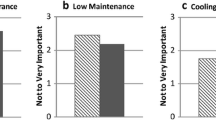Abstract
In a recent national survey of federal wilderness managers, respondents identified the high priority need for scientific information about public attitudes toward biophysical intervention to adapt to climate change and attitudes of the public toward restoration of natural conditions. In a survey of visitors to one National Park wilderness in California, visitors revealed that they largely do not support biophysical intervention in wilderness to mitigate the effects of climate change, but broad support for activities that restore natural conditions exists. In an attempt to understand how these attitudes vary among visitors, it was found that those visitors who most value naturalness aspects of wilderness character also most positively support restoration and are most negative toward climate change intervention practices. More information about visitor-defined wilderness character attributes is needed and strategic planning to guide intervention decisions and restoration should be a priority. In this study, it was found that wilderness character is largely defined by visitors based on its wildness attributes, which include natural sounds, low density of people, pure water, clean air, and the presence of humans substantially unnoticeable.

Similar content being viewed by others
References
Aplet G, Thomson J, Wilbert M (2000) Indicators of wildness: using attributes of the land to assess the context of wilderness In: McCool SF, Cole DN, Borrie WT, O’Loughlin J comps (eds). Wilderness science in a time of change conference—Volume 2: Wilderness within the context of larger systems; 1999 May 23–27; Missoula, MT. Proceedings RMRS-P-15-VOL-2. U.S. Department of Agriculture, Forest Service, Rocky Mountain Research Station. Wilderness Management Conference in Missoula, Ogden
Carhart AH (1961) Planning for America’s wildlands: a handbook for land-use planners, managers and executives, committee and commission members, conservation leaders, and all who face problems of wildland management. National Audubon Society, National Parks Association, The Wilderness Society, and the Wildlife Management Institute, The Telegraph Press, Harrisburg
Carver S, Watson A, Waters T, Matt R, Gunderson K, Davis B (2009) Developing computer-based participatory approaches to mapping landscape values for landscape and resource management. In: Geertman S, Stillwell JCH (eds.) Planning support systems best practice and new methods, Series: GeoJournal Library, Vol. 95, XXII. Springer, Berlin, p 490. http://www.springerlink.com/content/v1748t364270jn22
Cole DN (1996) Ecological manipulation in wilderness—an emerging management dilemma. Int J Wilderness 2(1):15–19
Cole DN, Landres PB (1996) Threats to wilderness ecosystems: impacts and research needs. Ecol Appl Ecol Soc Am 6(1):168–184
Frenzel E, Fauth G (2014) Sequoia and Kings Canyon National Parks Wilderness Character Assessment: An examination of the characteristics and conditions of designated and proposed wilderness in Sequoia and Kings Canyon National Parks, June. p 41
Ghimire R, Green, GT, Cordell HK, Watson A, Dawson CP (2015) Wilderness stewardship: a survey of National Wilderness Preservation System managers. Int J Wilderness 21(1):23–28
Hair JF, Black WC, Babin BJ, Anderson RE, Tatham RL (2006) Multivariate data analysis, 6th edn. Pearson Prentice Hall, Upper Saddle River, p 899
Landres P, Cole D, Watson A (1994) A monitoring strategy for the National Wilderness Preservation System. In: Hendee JC, Martin VG (eds) International wilderness allocation, management, and research. Fort Collins, International Wilderness Leadership (WILD) Foundation, pp 192–197
Landres P, Barns C, Dennis JG, Devine T, Geissler P, McCasland CS, Merigliano L, Seastrand J, Swain R (2008) Keeping it wild: an interagency strategy to monitor trends in wilderness character across the National Wilderness Preservation System. General Technical Report RMRS-GTR-212. Rep. General Technical Report RMRS-GTR-212, U.S. Deptartment of Agriculture, Forest Service, Rocky Mountain Research Station, Fort Collins (Wilderness Character Monitoring guidebook)
Martin SR, Blackwell J, Watson AE (2014) Sequoia and Kings Canyon National Parks (SEKI) Wilderness: 2011 visitor survey data. Forest Service Research Data Archive, Fort Collins. doi:10.2737/RDS-2014-0024
Ridder B (2007) The naturalness versus wildness debate: ambiguity, inconsistency, and unattainable objectivity. Restor Ecol 15(1):8–12
Tricker J, Landres P, Fauth G, Hardwick P, Eddy A (2014) Mapping wilderness character in Sequoia and Kings Canyon National Parks. Natural Resource Technical Report NPS/SEKI/NRTR—2014/872. National Park Service, Fort Collins
Watson Alan E (1995) Opportunities for solitude in the Boundary Waters Canoe Area wilderness. North J Appl For 12(1):12–18
Watson AE (2004) Human relationships with wilderness: the fundamental definition of wilderness character. Int J Wilderness 10(3):4–7
Watson AE, Williams DR (1995) Priorities for human experience research in wilderness. TREND/Wilderness Res 32(1):14–18
Watson A, Martin V, Lin CC (2009) Wilderness: an international community knocking on Asia’s door. J Natl Park (Taiwan) 19(4):1–9
Wuerthner G, Crist E, Butler T (2014) Keeping the Wild: against the domestication of earth. Island Press, Washington, p 272
Acknowledgments
The authors gratefully acknowledge funding and other support from Sequoia and Kings Canyon National Parks, the Aldo Leopold Wilderness Research Institute, and Humboldt State University. A special thanks to all of the heartfelt responses from over 600 wilderness visitors.
Conflict of interest
There are no conflicts of interest.
Author information
Authors and Affiliations
Corresponding author
Rights and permissions
About this article
Cite this article
Watson, A., Martin, S., Christensen, N. et al. The Relationship Between Perceptions of Wilderness Character and Attitudes Toward Management Intervention to Adapt Biophysical Resources to a Changing Climate and Nature Restoration at Sequoia and Kings Canyon National Parks. Environmental Management 56, 653–663 (2015). https://doi.org/10.1007/s00267-015-0519-8
Received:
Accepted:
Published:
Issue Date:
DOI: https://doi.org/10.1007/s00267-015-0519-8




